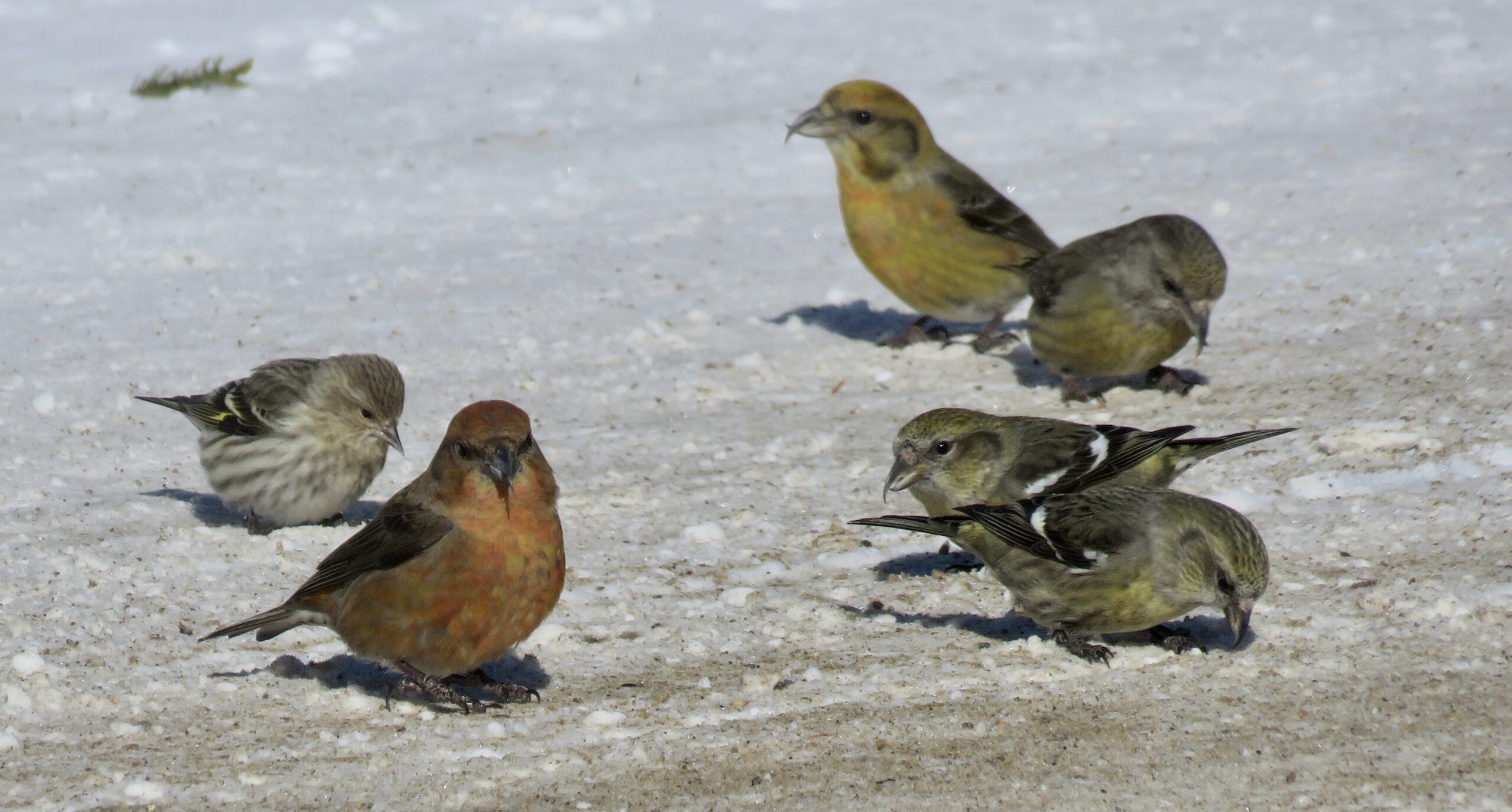By Matt Young:
Red crossbills (Loxia curvirostra) are the archetypal example of a taxon with high infraspecific diversity in traits including bill size and especially vocal characteristics. Currently, at least 11 different call types in North America have been recognized. With the 2023-2024 cone crop year and epic Type 2 and 4 Red Crossbill invasion a year behind us, it’s time to give you a yearly update and an overview of this year’s (2024-2025) Adirondack cone crop and beyond for crossbills and more. The cone cycle year for a crossbill is approximately July 1-June 30th. Crossbills start moving around more come May-June when they start looking for the next developing cone crops, so the below report will only focus on July-April 2024-2025.
Last year was a great Eastern white pine cone crop across much of the Northeast and 3-4 Red Crossbill call types (Types 2,4 and 12) used the crop abundantly for a good 8-9 months. Each year’s crop is different, which often leads to a different cast of characters. First, it is useful to make mention and show that the overwhelming majority (>95%) of last year’s invading Type 2 and 4 Red Crossbills very likely retreated back to their core zones of occurrence in the western United States and Canada.


In the above maps of Type 2 and 4 from the past two years, one can see how they moved in, and are almost absent a year after the irruption with 10 or less signings of each. This is typical in my 20 years of watching this unfold, as the invaders likely move back into core zones of occurrence where they were born. Both Type 2 and 4 are most common in the western part of the United States and Canada.
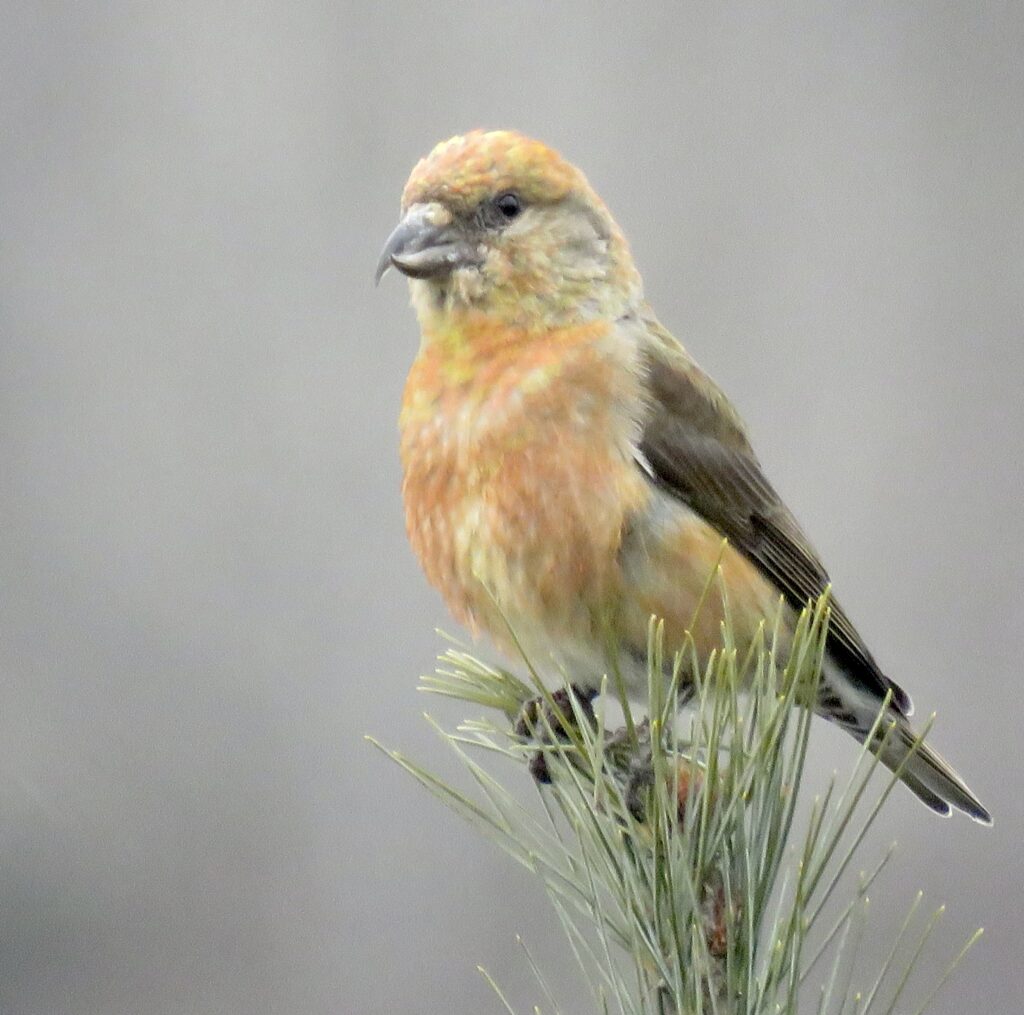
The Red Crossbill is known for using their unique bill for prying seeds out of conifer cones, but unlike the White-winged Crossbill, it is known to also be able to use a much wider variety of conifers to meet their energy requirements for nesting. This is due to this species having a stronger jaw musculature. Here in the east and upstate NY, it can get at seeds from soft-coned conifers such as spruces (i.e. red and white spruce) and hemlocks; the semi-soft coned conifer eastern white pine; and hard coned pines such as red, jack, pitch, scotch and Japanese black pines. I explain below areas where both crossbill species occurred in the Adirondacks the last two winters — I also explain some of the species that both species key in on.

One of the obvious things that jumps out in the above two maps is that the Adirondacks appears to be one of the strongholds for Red Crossbills in the east. This is not surprising since the Adirondacks has perhaps the highest diversity and density of conifers in the northeast where red spruce, Eastern white pine, and Eastern hemlock achieve excellent growth. There are also lots of supplemental conifer plantings of red pine across the area as well. In a rapid 2024-25 food crop assessment of key conifers, red spruce rated a 6.6 (n=102) with many areas in the central Adirondacks ranging 7-8 but other areas surprisingly poor in the 3-4 range. Many times crops synchronize areas wide areas within a state and across many states, but the good red spruce crop and great Eastern hemlock crops appeared to be mainly just localized to the core areas of the interior Adirondacks. The hemlock crop in these areas was 9.1 (n=76). The scale used is 1-11, and can be found here at this iNaturalist project link: https://www.inaturalist.org/projects/become-a-finch-forecaster-finch-forecast-food-assessment
The red spruce crop was very spotty in most areas of the Northeast. Where these crops were rated at least a 5-6, Red Crossbills could be heard signing in the central Adirondcaks in February-March. Pine Siskins were also more common in these areas, especially in areas where hemlocks co-existed with the red spruce. Pine Siskins flocks often numbered 25-50 birds, but a few were seen starting to pair.

Red Crossbills were fairly common and appeared to be breeding from areas around Clear Lake to Newcomb and Minerva in January to April.

In the above Type 12 “Northeastern” Red Crossbill maps, one can see how the Adirondacks is still a stronghold for it given there were 4-5 times more sightings in 2024-25 than for invading types Type 2 and 4. While these maps are far from perfect, as recordings to call type can often be driven by a couple dedicated field recordists, it does show how the local type remains and the invading type appears to retreat back to where they came.

Type 1 is the other call type common in the east and it has only been recorded six times in the Northeast so far this cone cycle year of July-April 2024-25 (see above map) –there were also a good number more around last year.

In the above map, see how the “Appalachian” Type 1 Red Crossbill is most common in the southern Appalachians.
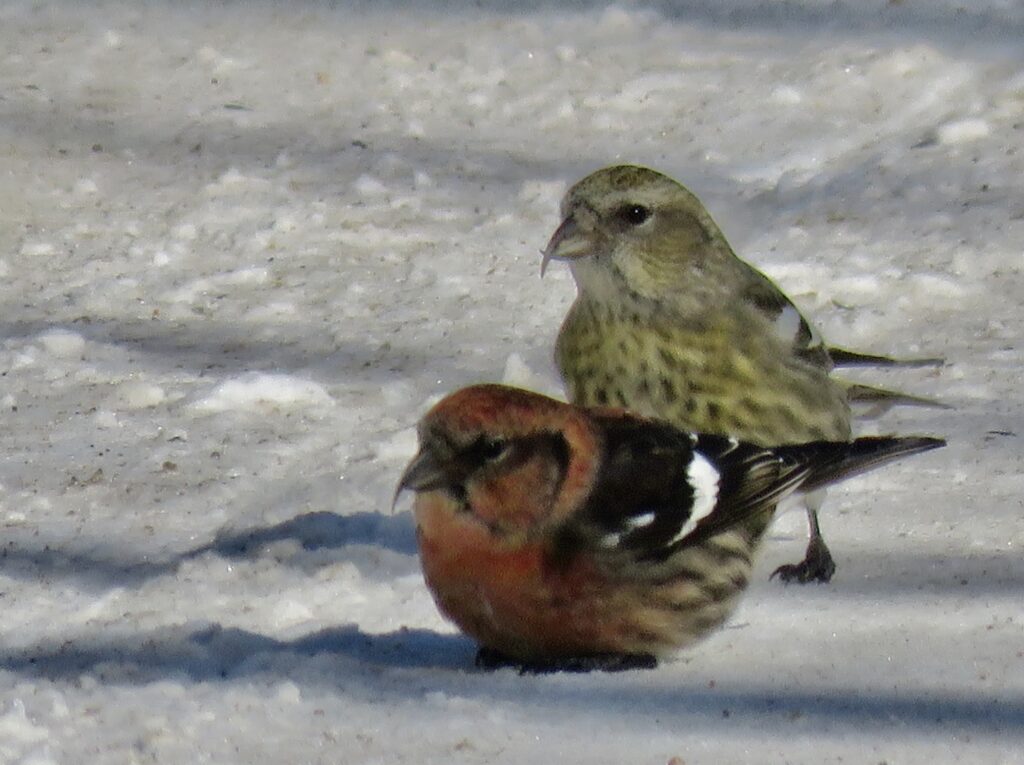
The White-winged Crossbill generally has a smaller bill than all the Red Crossbill call types except for the hemlock-loving Type 3. When it comes to North American crossbill complex, it really should be seen as the boreal crossbill, as it is by far the most common crossbill across Canada. It does not have the jaw musculature of that of the Red Crossbill, and therefore cannot utilize the wide variety of conifers efficiently like the Red Crossbill. It primarily utilizes white and black spruce, and tamarack across the boreal forest. At the periphery of its breeding range, it also utilizes Sitka spruce along the coast of British Columbia and Alaska, Engelmann spruce in the interior areas of the Cascades and southern Rockies, and red spruce in the Northeast.

In the above map White-winged Crossbills are present in both years in the Adirondacks. Birds were more keyed in on the average black spruce crops in 2023-2024 and more so the same areas with the good red spruce crops in 2024-2025. These two species often occur in close proximity to one another, black spruce in the bog proper, and red spruce in the adjacent edge of the bogs. This was noted particularly in areas around Sabbattis Bog, Bloomingdale Bog, the bogs at John Dillion Park and along Blue Ridge Roads. Red Crossbill Type 12 were also noted in these same areas this past winter and spring.

Many White-winged Crossbills moved into the southern edge of their typical wintering ranges in the Adirondacks but also in the UP Michigan and the Sax Zim Bog areas and surroundings in Minnesota. A big movement of White-winged Crossbill back in November led to them moving into the Adirondacks in numbers, but also to birds showing up in Bermuda for the first time in approximately 20 years (see purple dot lower right). Those birds are still present in Bermuda as of mid April. Both Crossbill species largely appeared in the east as the forecast predicted.
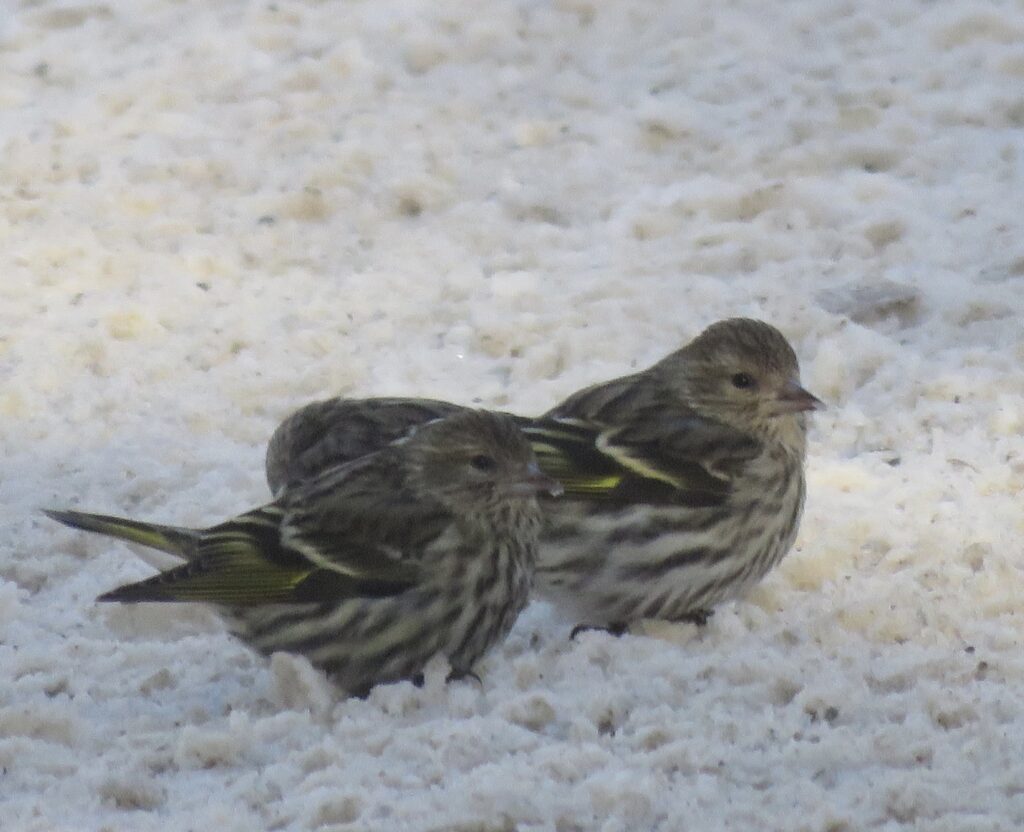
It was a smaller Pine Siskin irruption event in the Adirondacks this past winter than the year before when birds were utilizing the generation Eastern white pine cone crop. During my rapid 20240-25 assessment of cone crops in the Adirondacks, Pine Siskins were common in areas where hemlock and red spruce co-occured — Around Clear Lake this was especially noteworthy. Pine Siskins are generalist compared to many of the other finches, and they were also seen utilizing birch and alder crops where their crops were decent. The crops on these species were better in the Adirondacks last year, but there were a few areas where crops had a few trees here and there with some catkin seed. Interestingly, birds become more common in the Adirondacks after January 1st, which is a pattern that existed last year as well – this is likely due to the seed becoming more assemble later in the cone cycle year. Siskins do not have the crossed bill to pry open the scale to access the seed, and so they are more reliant on the aging and weathering of the crop.


Pine Siskins appeared to be starting to pair off in areas of the central Adirondacks where the hemlock crop was excellent.

Pine Siskins waged a small irruption southward in the eastern part of the United States during the winter 2024-25.
Evening Grosbeak Road to Recovery Project

As one can see, Evening Grosbeaks appear to now mostly nest in the eastern part of the Adirondacks. As mentioned in previous Finch Research Network articles and reports , the Evening Grosbeak (Coccothraustes vespertinus) has declined 92% since 1970, and therefore was cited as the steepest declining landbird in the continental United States and Canada in the Partners in Flight 2016 Landbird Conservation Plan. It has been designated a “road to Recovery” bird.
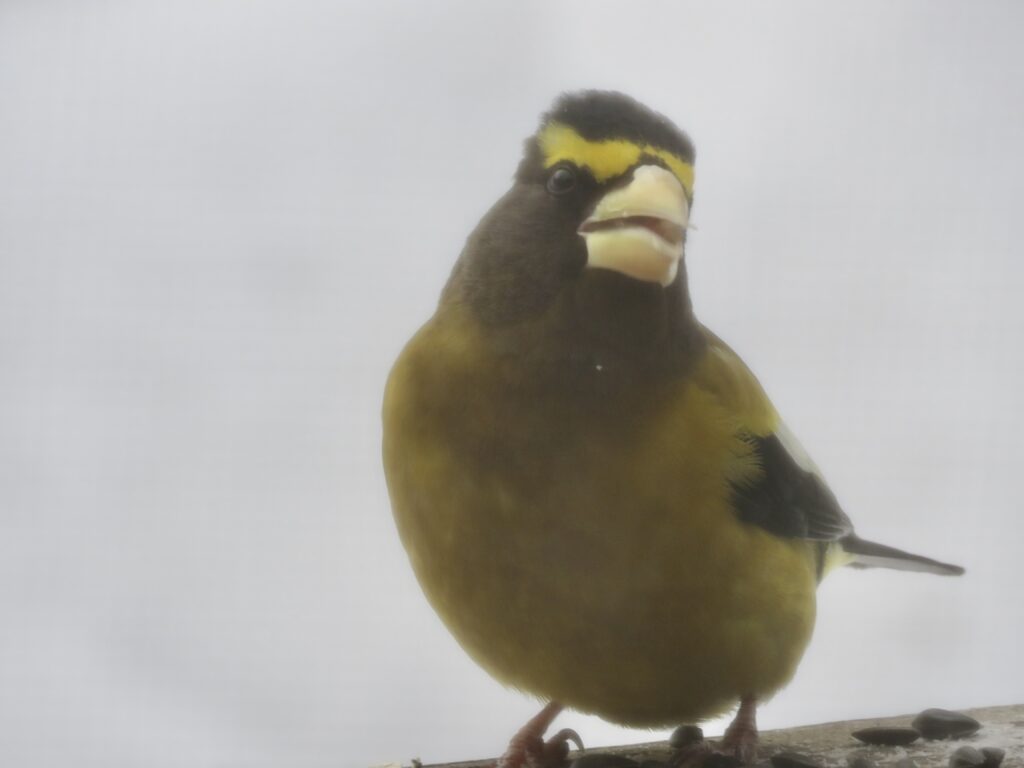
The Evening Road to Recovery project is a collaborative team effort with many organizations, agencies and nonprofits across North America, but it spearheaded by Powdermill Avian Reserve, Carnegie Museum of Natural History, the Western Pennsylvania Conservancy (WPC) at the Pennsylvania Natural Heritage program, and Finch Research Network (FiRN). FiRN and the rest of the team are continually looking for areas to band and tag birds across the United States to better understand why the Evening Grosbeak is declining so dramatically. The Adirondacks is an area of interest for this project, as it serves as both a breeding zone and an irruption zone. The team banded 13 birds, and deployed another 6 radio tags and 6 satellite tags near the Paul Smiths and Rainbow Lake areas this past February (see first map below).

Here is a chart below showing the entirety of the banding and tagging efforts since the project first started as a Pennsylvania Wintering study, and then in fall of 2021 became a designated International Road to Recovery Project.


Tyler Hoar and the Finch Research Network predicted a moderate northeastern and Great Lakes invasion for this past winter, but the irruption turned out to be more of a small scale event. Evening Grosbeaks were certainly more common than last winter 2023-24 (see the deeper purple in the Adirondacks and Northeast on the map to the right), but numbers were lower than anticipated in New York and across the east (see above and below maps).

Other Finches
I am adding the other finches to this report as well, but I’ll keep it brief, as Redpolls and Pine Grosbeaks were scarce to non-existent this past winter in the Adirondacks. The Pine Grosbeak did wage a small irruption while the Redpoll waged a moderate sized irruption into the western Great Lakes areas (see below first 4 maps). The Winter Finch Forecast was pretty much spot on for their prediction for these two species.


There was a significant event across the west last winter, but there were no irruption events noted across its range this winter.

We did not predict a big redpoll movement for this winter, but did suggest something could materialize in the western Great Lakes. On the below eBird Redpoll map see the deep purples for areas of the western Great Lakes, especially in Minnesota.

The Winter Finch Forecast predicted a moderate flight of Purple Finches for the eastern half of the United States, and one can see that materialized in the below map.

Purple finches were predicted to have a moderate sized irruption across the eastern half of the United States, and one can see in the below map that indeed materialized.

We’ll continue to draft and release the Winter Finch Forecast every fall for the eastern half of North America, with the Adirondacks serving as an important area to do a more detailed finch food assessment, particularly for crossbills (especially for Northeastern Red Crossbill Type 12), Evening Grosbeaks and the other finches that visit the region.
Book Link
For help with Finch ID and much much more, here is a link to the exciting and newly released Stokes Guide to Finches of the United States and Canada: https://www.amazon.com/Stokes-Finches-United-States-Canada/dp/0316419931
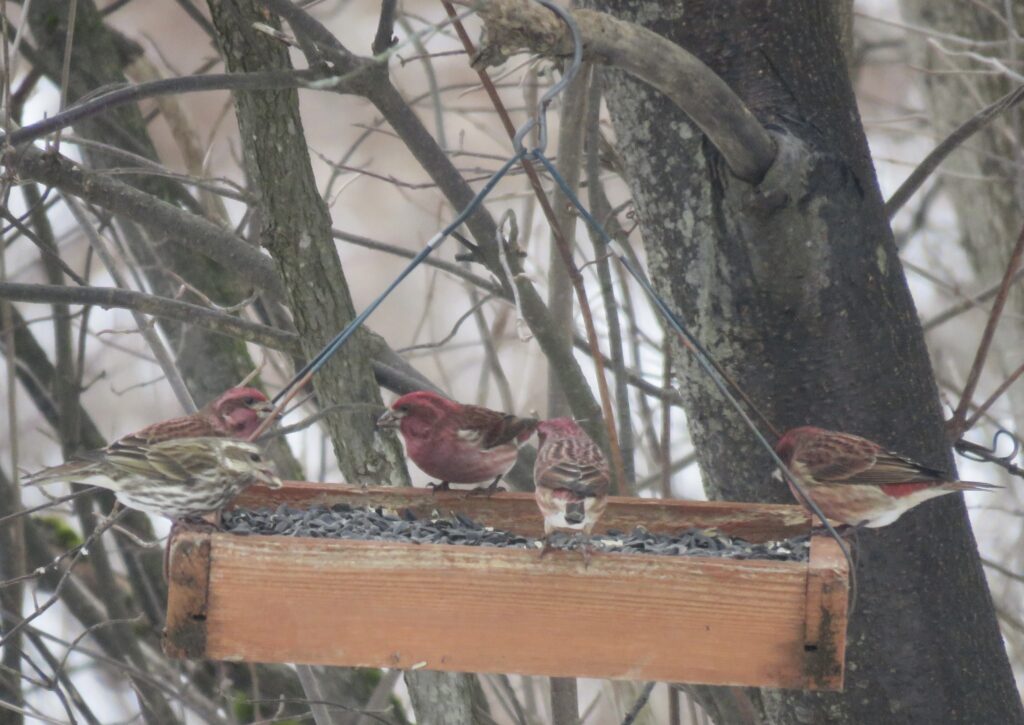
To read last year’s Adirondack cone crop and Red Crossbill report click here: https://finchnetwork.org/red-crossbill-loxia-curvirostra
The Finch Research Network (FiRN) is a nonprofit, and was granted 501c3 status in 2020. We are a co-lead on the International Evening Grosbeak Road to Recovery Project, and have funded $22,000+ to go towards research, conservation and education for finch projects in the last couple years. FiRN is committed to researching and protecting these birds like the Evening Grosbeak, Purple Finch, Crossbills, Rosy-finches, and Hawaii’s finches the honeycreepers.
If you have been enjoying all the finch forecasts, blogs and identifying of Evening Grosbeak and Red Crossbill call types (20,000+ recordings listened to and identified), redpoll subspecies and green morph Pine Siskins FiRN has helped with over the years, please think about supporting our efforts and making a small donation at the donate link below. The Evening Grosbeak Project is in need of continued funding to help keep it going.
Donate – FINCH RESEARCH NETWORK (finchnetwork.org)
Please think about joining Finch Research Network iNaturalist Projects:
Winter Finch Food Assessment Project/Become a Finch Forecaster: https://finchnetwork.org/the-finch-food-assessment-become-a-finch-forecaster
Red Crossbill North American Foraging Project: https://finchnetwork.org/crossbill-foraging-project
Evening Grosbeak North American Foraging Project: https://finchnetwork.org/evening-grosbeak-foraging-project

